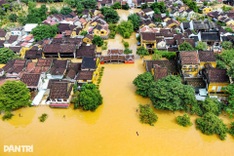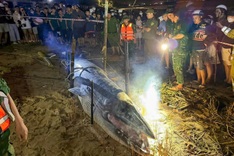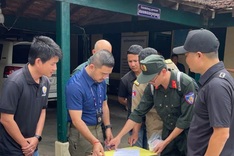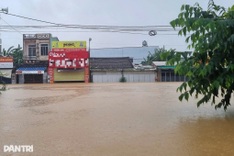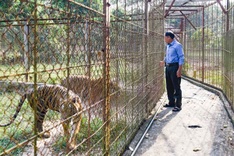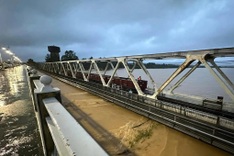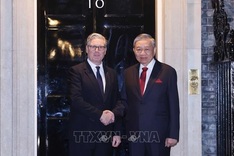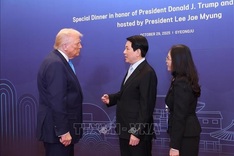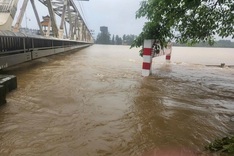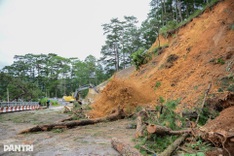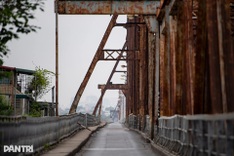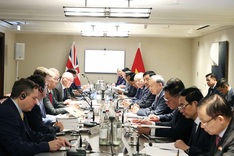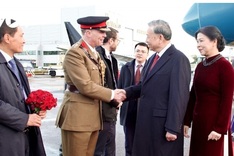If the charm of a city is to be found in its architecture, then Phnom Penh is less alluring than it used to be.
 |
| The Gift of Napoleon III building, in front of the Royal Offices inside the Royal Palace Compound in Phnom Penh. (Anders Blomqvist/LPI) |
Its yellow-washed, green-shuttered, colonial-era buildings and angular, post-independence "new Khmer" architecture were both, rightly, renowned. They contributed to the low-rise elegance of the city, and even today’s travel guides and websites refer to Phnom Penh’s past as the “pearl of Asia”. But as land owners increasingly prize financial yield over urban heritage, the architecture is being lost.
Top Cambodian architect Vann Molyvann\'s striking 1960s National Theatre was among the most notable casualties. Its triangular form resembled a ship, entirely fitting for its location near the banks of the River Bassac.
The theatre pre-dated the much larger, similarly-inspired, Sydney Opera House. But a fire in 1994 caused substantial damage, and despite a series of plans and promises it was never repaired. And when a well-connected property developer took control of the site, it demolished the theatre in 2008. Now all that remains is wasteland, surrounded by a blue, corrugated metal fence.
Another of Vann Molyvann’s constructions was the National Sports Complex popularly known as the Olympic Stadium. It is still standing, but obscured by newly-built shophouses and even a mall, which rob the design of the impact it made when open space surrounded it.
Colonial-era buildings are just as likely to suffer. There is a vacant lot where an elegant municipal tourism building once stood on the riverfront – and National Bank employees park their motorbikes on the site of another demolished colonial classic.
Architect Yam Sokly reckoned a third of the buildings in central Phnom Penh have come down over the past decade and a half – mostly in the past five years. He said that without properly-enforced conservation laws, that trend is likely to continue.
“The main problem is basic knowledge, the understanding and appreciation of urban heritage. Some of these buildings are not even 50 years old, which makes them too new for some people to accept them as heritage.”
Sokly is involved in an effort to change that. He leads groups as part of Khmer Architecture Tours. The company offers tourists – and residents – a different perspective of Phnom Penh, one which may open their eyes to the treasures in their midst.
The original idea was beautiful in its simplicity – a downloadable map with buildings of interest marked on them. People were, and still are, free to work out their own itinerary for walking, cycling or driving around the architectural attractions.
But it soon became clear that there was a demand for more information. So Khmer Architecture Tours started to offer guided itineraries, led by qualified architect
There are currently various options, from 1960s public housing projects to tours of the Olympic Stadium and university buildings. But for a uniquely Cambodian experience, the prize goes to the cyclo tours of the city centre.
Just like Phnom Penh’s classic buildings, the cyclo is an endangered species – a three-wheeled, pedal-powered beast with a comfortable seat for a passenger or two at the front, while the driver perches on high at the rear.
Once the main form of public transport in Phnom Penh, the cyclo is getting gradually pushed out by cars, motorbikes and tuk-tuks. Tourism offers the best hope to their drivers – typically middle-aged farmers from the provinces coming in to the city to earn money between rice harvests.
Leaning back in the cyclo, moving at a stately pace, makes it easy to appreciate the aesthetic attractions of the city. On a typical tour, Sokly calls the convoy to a halt outside the most interesting buildings, so he can add some context.
There is the Post Office, a yellow-washed beauty surrounded by the finest collection of colonial-era buildings in Phnom Penh. Some are dilapidated but others have been spectacularly restored, including the former Bank of Indochina building, which now houses a fine-dining restaurant with an excellent view across the square.
Then there is Central Market (as it is known to tourists; its real name is Psar Thmey, or New Market) – also recently restored – an enormous, yellow, Art Deco UFO which has landed in the middle of the city.
A short cyclo ride along the riverfront brings the tour to famous landmarks including the National Museum, the Royal Palace and a well-preserved Vann Molyvann design, the Chaktomuk Conference Centre – all diagonal pillars and triangular motifs.
Sokly is also keen to point out the less obvious gems – a French-style public toilet on the corner opposite the museum, decommissioned cinemas occupied by squatters, private houses and shophouses.
“We try to show people the most important places from both the colonial and post-independence eras,” said Sokly. “Most people are impressed. Even if they have lived here for years, they have not been aware of some of the buildings.”
Sokly is aware that just impressing the tourists will not be enough to stop the demolition of more classic buildings. So Khmer Architecture Tours is planning to offer its services to Phnom Penh’s high schools, to give the students an early primer on urban heritage. “They are the future. They could take care of these buildings.”
If so, Phnom Penh may regain its title as the pearl of Asia.



